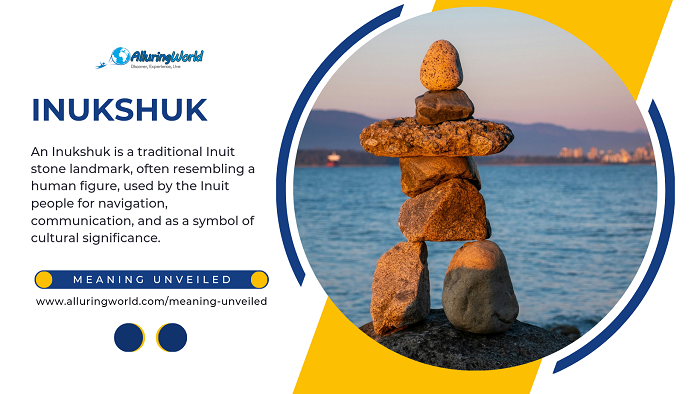Read time ca. 4 minutes
In the vast landscapes of the Arctic, the Inukshuk stands as an enduring symbol of Inuit culture, with its stacked stones forming human-like figures, and as it is more than just a marker in the icy expanses, the Inukshuk holds deep cultural, spiritual, and practical significance for the Inuit people. Delving into the multifaceted meanings and the integral role of the Inukshuk in Inuit culture, here is the unveiled meaning of this great Inuit symbol.
Navigational Guides:
The term “Inukshuk,” derived from the Inuktitut language, succinctly encapsulates its meaning – “in the likeness of a human.” Rooted deeply in Inuit culture, Inukshuks hold significant importance as practical and cultural symbols, and as they are serving as more than mere piles of stones, these structures have been integral to the survival and navigation of the Inuit people in the expansive and often unforgiving Arctic landscapes.
In the heart of the Arctic, where landmarks are few and far between, Inukshuks take on a crucial role as navigational aids. The Inuit, who in fact are excellent seasoned hunters and skilled travelers, ingeniously devised these stone formations to provide directional guidance across the featureless expanses of snow and ice. The artful arrangement of stones in human-like shapes not only ensures their visibility against the stark white backdrop but also signifies the ingenuity of the Inuit in adapting to their cold and quite harsh environment. Thus, Inukshuks stand not only as practical guides but also as cultural beacons, embodying the symbiotic relationship between the Inuit people and their surroundings.
Symbol of Survival:
Beyond its role as a navigational aid, the Inukshuk emerges as a profound symbol of survival within Inuit culture. Crafted by Inuit communities, these stone structures are not merely arbitrary arrangements; rather, they serve as a silent language conveying critical information about the Arctic environment. In the vast expanses of the Arctic, where survival hinges on resourcefulness and adaptability, Inukshuks become integral messengers of crucial details, such as the whereabouts of essential resources like food and water, or the presence of perilous terrain.
The construction and interpretation of these stone figures represent a skill set honed by generations of Inuit people, becoming an essential component of their survival toolkit. The ability to decipher the nuanced messages encoded within the Inukshuks is a testament to the intricate knowledge and deep connection that the Inuit have with their surroundings, and in the face of the unforgiving Arctic conditions, these silent stone sentinels embody not only the resilience of the Inuit people but also the harmonious relationship they maintain with the land they call home.
Spiritual Significance:
In addition to all this, the Inukshuk also holds spiritual importance within Inuit culture. Some believe that these stone figures embody spirits or ancestors, serving as guardians watching over the land and its people. In this way, the Inukshuk becomes a connection between the physical world and the spiritual realm, intertwining the cultural and natural elements of Inuit belief systems.
Cultural Identity and Expression:
Inukshuks transcend their functional roles and they in fact become poignant expressions of cultural identity within Inuit communities. Beyond their initial intention of serving as practical navigational aids, each Inukshuk is a unique manifestation of cultural heritage and individual artistry. Crafted with distinctive characteristics, these stone structures encapsulate the essence of local traditions, weaving a tapestry of cultural identity that is passed down through generations.
In the intricate art of Inukshuk construction, community members and individuals infuse their creations with personal touches, embodying a form of storytelling through stone. The diverse designs and arrangements encapsulate the collective wisdom, values, and aesthetic sensibilities of the Inuit people. As silent narrators of cultural narratives, Inukshuks serve as conduits for the transmission of knowledge from one generation to the next, fostering a deep connection between the past and the present. In this way, the Inukshuk stands not only as a symbol of artistic expression but also as a living testament to the resilience and continuity of Inuit culture.
Modern Symbolism:
Although deeply rooted in ancient traditions, the Inukshuk has gracefully transcended its original purposes, carving out a meaningful place in today’s modern society. Evolving beyond its historical roles, the Inukshuk has become a symbol of universal significance, embodying values such as friendship, cooperation, and welcoming, and this ancient creation has even found contemporary relevance, notably being adopted as a symbol for events like the 2010 Vancouver Winter Olympics.
In the context of modernity, the Inukshuk carries a poignant message that extends beyond its cultural origins as it stands as a powerful emblem of unity and harmony, transcending cultural boundaries and resonating with people from diverse backgrounds. As a symbol of shared values and collective aspirations, the Inukshuk has the remarkable ability to bridge the gap between ancient traditions and the contemporary world, illustrating how cultural heritage can be a source of inspiration and connection in our globalized society. In this way, the Inukshuk serves as a timeless testament to the enduring qualities that bind humanity together.
Environmental Stewardship:
In recent times, the Inukshuk has taken on new significance as a symbol of environmental stewardship. Inuit communities, facing the impacts of climate change, use the Inukshuk to draw attention to the importance of preserving their fragile Arctic ecosystem, and it serves as a poignant reminder of the interconnectedness between culture, nature, and the urgent need for environmental conservation.
Conclusion:
In conclusion, the Inukshuk is far more than a mere arrangement of stones; it is a cultural cornerstone, a navigational guide, and a spiritual emblem deeply embedded in the fabric of Inuit identity. As the Inuit people continue to navigate the challenges of the modern world, the Inukshuk stands resilient, reminding them of their cultural heritage and the enduring strength derived from the land they call home.

